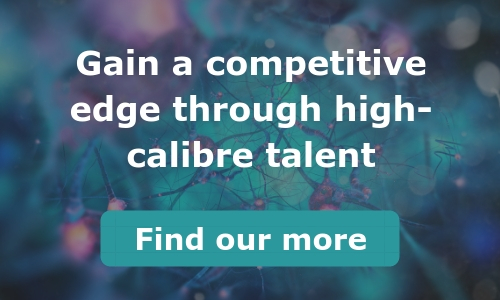Workplace diversity, or lack thereof, is a hot topic across boardrooms and Human Resources departments the world over, and the life science industry is no exception. While most people won’t deny the benefits of creating an inclusive and respectful atmosphere in the workplace, not to mention the innovation and productivity gains it can unlock, many organisations continue to struggle to implement diversity plans. It can be a challenge to navigate, with advantages and disadvantages to consider, but the results are worth it. Organisations that actively pursue workplace diversity benefit far more greatly than those who don’t.
Not only do organisations that embrace workplace diversity increase productivity and efficiency, but it can also simplify the hiring process; exemplary candidates will seek out your organisation, rather than you pursuing them. An organisation with a positive stance on workplace diversity is appealing to candidates from underrepresented groups who want to feel genuinely valued and respected within the workplace.
Some points worth considering:
- 87% of global organisations are committed to implementing a diverse workforce, although some admitted there’s a long way to go to achieve this.
- 67% of job searchers consider diversity an important factor when considering a new employment opportunity.
- In a survey, more than half (57%) of employees believe their organisation should be doing more to increase the diversity of their workforce.
What is diversity?
There are two different types of diversity:
- Inherent diversity: inherent diversity is comprised of demographic traits (e.g. sex, age, race etc.) that you are born with.
- Acquired diversity: acquired diversity is traits gained through experiences, such as previous employment and education.
When a workplace is diverse, people with both inherent and acquired characteristics such as gender, age, race, education, will embody the workforce. However, workplace diversity isn’t just about hiring people from underrepresented groups. It’s about creating an environment in which employees can thrive, be themselves and participate in the organisation. Overall, it’s about recognising everyone as unique individuals and appreciating what they can contribute that’s different from what their peers can.
What are the benefits of workplace diversity?
Workplace diversity can benefit the organisation in the following ways:
1. It bolsters an organisation’s reputation: Your reputation should be appealing in both the eyes of your customers and employees. When your workforce is diverse, the organisation appears inclusive and is far more likely to attract top talent. Candidates searching for new opportunities will be attracted to your organisation like a magnet, particularly if they belong to a minority community. They’ll see that you don’t discriminate against people from underrepresented groups and eagerly apply, exposing you to qualified candidates. This can additionally have a positive impact on your employer brand.
2. It exposes a bigger talent pool: Widening your search for a more diverse workforce can open up larger talent pools. This is particularly relevant for small and medium-sized enterprises (SMEs) and startup life science organisations who are limited in their geographical catchment.
3. It increases productivity: A diverse workforce will consist of employees with a broad range of experiences and backgrounds. The best way for innovative ideas to be formed and problems to be solved is with a diverse team who approach situations in different ways. Bouncing ideas off of one another allows you to learn and implement better business decisions. A team that resembles the fabric of society and works together helps to drive organisational success.
RELATED: Increase quality-of-hire by partnering with a reputable boutique talent consultancy
With a diverse workforce, there are immediate and tangible benefits to reap:
1. Diverse teams perform better: If your workforce is made up of employees who are from the same geographical area, educated to the same level and have followed identical career paths, stagnant, unoriginal ideas are all that they’ll contribute. When problems arise, they will inevitably approach it in the same manner, which not only produces lacklustre ideas but is also ineffective in the long run to achieve your organisational objectives.
A diverse team consisting of people from different backgrounds and demographics will bring fresh ideas and perspectives to the table. An organisation that accepts that its employees have unique personalities allows them to thrive and flourish. As a result, diverse teams drive innovation, creativity, implement new ways of doing things and enhances problem-solving within your organisation.
2. There’s higher employee engagement: When you create an atmosphere in which employees feel respected and included, this naturally results in them feeling more engaged and loyal. Organisations should strive to build a workforce made up of talented, diverse individuals who enjoy working for you. Employees who enjoy working are productive and produce high-quality work. This is attractive to candidates searching for new positions and who are considering working for your organisation; if they’re greeted with an engaged, attentive workforce when they research you, they will all want to work for you. In fact, 67% of job seekers consider workplace diversity an important factor when considering a new employment opportunity. High employee engagement can also help to boost your employer brand.
3. There’s reduced employee turnover: When employees feel engaged and valued, they are happier within the workplace. When an employee feels valued and happy, they are less likely to jump ship and find new opportunities elsewhere. The more satisfied an employee, the more loyal they are to your organisation. No hiring manager wants to deal with constant resignations and hiring upheavals, but by halting the problem in its tracks and investing in diversifying your workforce, you’ll have a significantly reduced employee turnover. Reduced employee turnover means that you can focus on nurturing your current employees.
What are the drawbacks of workplace diversity?
While workplace diversity is of vital importance, it’s important to consider the potential drawbacks and whether it might be worth actioning a plan to combat it:
- Too many opinions: An excessive number of opinions can be counterproductive in the workplace. With too many opinions, you risk failing to reach a consensus, which as a consequence can reduce productivity and slows projects down.
- Hostility and social tensions: Clashes in opinions can create disagreements amongst colleagues, especially if in your quest to create a more diverse workplace, you fail to implement diversity training. Entrenched prejudices can cause some employees to struggle to accept and trust diverse employees. They might start arguments or even avoid communicating with one another altogether, which diminishes productivity significantly and creates a terrible workplace atmosphere.
- Communication issues result in lower productivity: As well as communication issues due to lack of trust, as outlined above, employees will be unable to communicate effectively if there are language barriers. When you hire more diverse candidates, inevitably not everyone will have the same language capabilities. If members of a team are ineffective at communicating with one another, then this will impact the productivity of the entire team, function or organisation.
- Emotional diversity can suffer: Diversity initiatives often focus on leadership roles, meaning that entry-level and intermediate roles can find themselves being neglected. Sustaining balance will help everything to remain inclusive and calm within your team.
- Chance of retaining bad talent: To maintain diverse teams, this can often mean that you hold onto employees who are ineffective in their current role simply because they reinforce your organisation’s stance on diversity. There’s a tendency to over-reward or compensate to maintain diversity.
Now that you’re aware of the benefits and drawbacks of workplace diversity, you can use this knowledge to create a plan to drive your company towards a more prosperous and diverse future.
For more hiring advice tailored to hiring managers in the life science industry…
- Read How To Attract Diverse Life Science Leaders With Your Employer Brand.
- View our talent solutions to see how we can help you gain a competitive edge through talent.
* Fraser Dove International is a talent consultancy operating exclusively across the life sciences industry. While our roots lie in executive search, we provide more than the traditional recruitment services. Uniquely placed within the market, we have been providing cutting-edge talent solutions and insight to organisations at all stages of their journey – from start-up to established leaders – since 2013.

 Estimated read time: 5 mins
Estimated read time: 5 mins Date posted:18/11/2019
Date posted:18/11/2019





